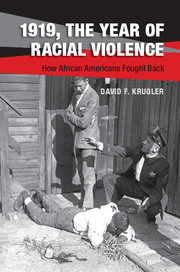Book contents
- Frontmatter
- Dedication
- Contents
- Acknowledgments
- Source Abbreviations and Usage Note
- Introduction
- 1 World War I and the New Negro Movement
- 2 “We Return Fighting”
- 3 Fighting a Mob in Uniform
- 4 Blood in the Streets
- 5 Armed Resistance to the Courthouse Mobs
- 6 Armed Resistance to Economic Exploitation in Arkansas, Indiana, and Louisiana
- 7 “It Is My Only Protection”
- 8 The Fight for Justice
- 9 The Fight for Justice
- 10 Fighting Judge Lynch
- Conclusion
- Bibliography
- Index
- References
9 - The Fight for Justice
The Death Penalty Cases
Published online by Cambridge University Press: 05 December 2014
- Frontmatter
- Dedication
- Contents
- Acknowledgments
- Source Abbreviations and Usage Note
- Introduction
- 1 World War I and the New Negro Movement
- 2 “We Return Fighting”
- 3 Fighting a Mob in Uniform
- 4 Blood in the Streets
- 5 Armed Resistance to the Courthouse Mobs
- 6 Armed Resistance to Economic Exploitation in Arkansas, Indiana, and Louisiana
- 7 “It Is My Only Protection”
- 8 The Fight for Justice
- 9 The Fight for Justice
- 10 Fighting Judge Lynch
- Conclusion
- Bibliography
- Index
- References
Summary
The Knoxville riot and the Arkansas pogrom both produced death penalty cases that vividly highlighted the consequences of racially biased court proceedings in 1919. In Knoxville, Maurice Mays was charged with killing a young white woman named Bertie Lindsey. A mob’s pursuit of rough justice – the attempted lynching of Mays – had expanded into widespread attacks on black residents. Armed resistance and the deployment of state militia to restore order did not delay Mays’s trial. Knox County Attorney General R. A. Mynatt presented the case against Mays to an all-white grand jury, which indicted Mays for murder just a few days after the riot ended. The rush to judgment was just as swift in Phillips County, Arkansas. Acting in concert with a massive posse, U.S. infantry troops had killed or captured most of the black sharecroppers who had resisted the violent campaign against their fledgling union. At the behest of white elites, special agents of the Missouri Pacific Railroad tortured the prisoners to extract “confessions” that the union men had plotted an uprising to murder whites. Brought to court in chains, these men did not even have a chance to speak to their attorneys before their trials began.
The cases bore many similarities. All-white juries in Knoxville and Phillips County speedily convicted the defendants and white judges promptly handed down death sentences. Mays and the sharecroppers were framed – let there be no doubt that every man was innocent of the charges against him. Prosecutors used unreliable eyewitnesses, corrupt forensics, and forced confessions to win over juries, which were already eager to deliver guilty verdicts. Authorities refused to give the defendants adequate time to prepare their defenses and flouted their respective states’ laws governing trial processes. By the end of 1919, execution loomed for Mays and the Elaine Twelve, as the condemned sharecroppers were called. But sustained legal efforts brought stay after stay as attorneys for all thirteen men fought to overturn the convictions and secure new – and fair – trials. In the case of Mays, the battle began with his adoptive parents, whose dogged efforts eventually gained support from the NAACP’s Tennessee branches.
- Type
- Chapter
- Information
- 1919, The Year of Racial ViolenceHow African Americans Fought Back, pp. 245 - 271Publisher: Cambridge University PressPrint publication year: 2014



